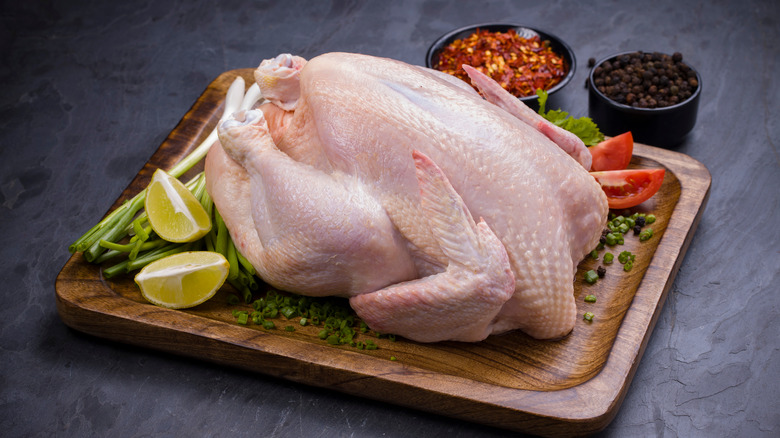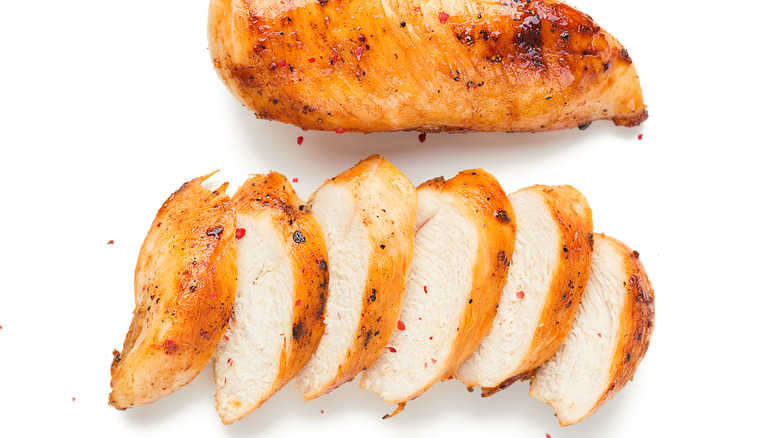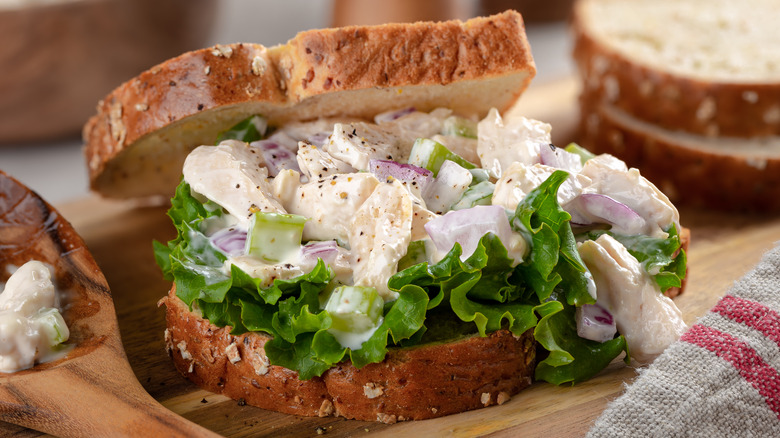The Best Part Of Chicken To Use For Chicken Salad
At first thought, the concept of chicken salad seems simple enough: Take some chicken, add a binder like mayonnaise, and incorporate a little crunch, such as onion or celery. Slap the mixture between two pieces of bread and lunch is served.
In reality, though, there are few staple dishes out there that are less simple. Digging deeper into this standby of potlucks and picnics produces countless variations on the beloved dish. Binders can come in the form of salad dressing, yogurt, sour cream, or even oil and vinegar. Anna Stockwell of Epicurious believes, however, that a true chicken salad should always have a creamy binder. Once you've got that, though, there is no limit to mix-ins and combinations — nuts, fruit, spices, herbs, vegetables, even cheese.
Serving your creation on bread? It's always a winner but certainly not a necessity. According to Southern Living, a scoop of chicken salad served on a plate with greens (you can add some bread on the side as an option) is oh-so-satisfying. With so many variations to experiment with, one discovers that, really, the only absolutely essential ingredient for chicken salad is ... chicken. So, what part of this irreplaceable ingredient is the best to use?
Chicken breast is best
The flavor of chicken breast is fairly mild (via Chicken Farmers of Canada), so how would it trump juicy, flavorful thigh or leg meat? It's all about texture, according to Nicole McLaughlin at All Recipes. While sautéing, poaching, or even grilling are good methods of cooking chicken, she prefers roasting boneless, skinless chicken breast in the oven at 300 degrees for 60 to 80 minutes because you'll get the best texture out of this cut — one that's succulent and pliant, perfect for shredding and slathering with your favorite ingredients.
Chicken is fully cooked when it reaches an internal temperature of 165 degrees — and when it reaches this point, McLaughlin points out, it'll be covered in juices from its time in the oven. As an added bonus, chicken breasts are a fantastic source of lean protein, with significantly less fat than their dark meat counterparts (per the Academy of Nutrition and Dietetics). According to WebMD, this lean protein provides a great way to get amino acids in your diet; these organic compounds help strengthen your muscles and provide other health benefits.
So, even with the endless array of decadent mix-ins you can add to your perfectly cooked and chopped or shredded poultry, chicken salad might be healthier than you realized — especially if you use the right part of the chicken.
Limited only by your imagination
Once the chicken breasts are cooked and cooled, the real fun begins. If you're still skeptical about the unfortunate stereotype of flavorless chicken breasts, remember, chicken salad is a vessel that allows the other ingredients to shine. Now is the chance to go crazy with whatever flavors your heart desires, using the versatile chicken breast as the perfect base (and McLaughlin notes that a little pan juice from preparing that chicken can bring some savory moisture to whatever mixture you concoct).
One popular variation on the classic chicken salad recipe combines sweet and savory elements: apples, pecans, celery, and spices. Try piling this on a light and airy croissant for a real treat. If you're looking to branch out from the popular mayonnaise binder, consider avocado; one version of chicken salad based on the fatty fruit also includes walnuts, Greek yogurt, and dried cranberries. Eat this one straight from the bowl or wrap it in some crunchy lettuce. The possibilities are truly endless, and each one can be a delicious, satisfying, and nutritious meal if you know how to use the chicken just right.


